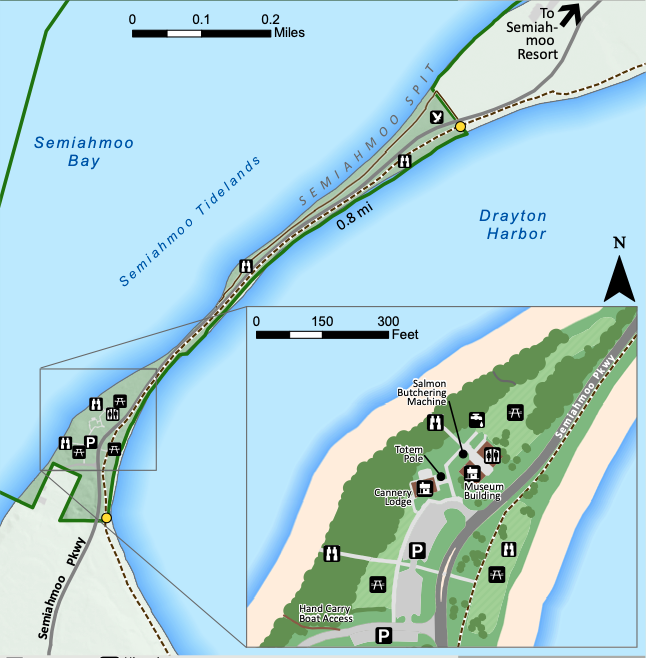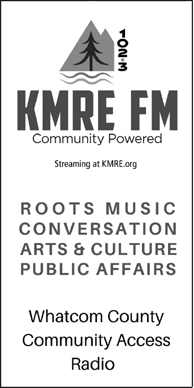by Margaret Wild
Semiahmoo is a “go to” place. It’s a milelong sandspit in the northwest corner of Washington state in the northwest corner of the country otherwise known as the “fourth corner” of the United States.
The name Semiahmoo means “halfmoon” in the Coast Salish language of the earliest people who settled there 20,000- plus years ago. It refers to the spit itself and the more recently developed resort area.
Birds love to gather there. Some make it their home. Many more are just passing by. They are a major attraction for me and many others who come from afar.

courtesy: Whatcom County
Diagram of Semiahmoo Spit
Start at Far End, Near Resort
I usually park at the far end of the spit near the resort and marina, then walk back to the opposite end, a mile away. Depending on the tide, I go straight to the beach facing north and comb the beach for special shells, stones, or pieces of driftwood with my head down, moving ever so slowly.
Along the way, I will stop to take in the 360-degree views. North to Canada. West to the islands. South to Mount Baker. East to the Cascade Mountain range.
Eventually, I leave the beach by way of a few steps to higher ground and pick up a trail that goes past a row of condos. This leads me into a dense growth of bushes, always filled with an assortment of small birds darting in and out of the thicket.
A few tall, barren trees provide a perfect perch for local eagles, especially since rabbits scramble about in the undergrowth.
It’s possible you’ll also notice boats coming in and out the marina, as well as large planes high in the sky and smaller planes cruising the local area. Depending on the time of year, you can enjoy an array of colorful wildfl owers and berry bushes.
Along the way, whether on the beach, trail, or sidewalk, there might be other folks walking, biking, chatting — ready to exchange a nod or brief hello.
Bench Halfway Down the Spit
About halfway down this side of the spit, there is now a handy bench with evergreen bushes around the sides and back providing some shade and protection from the wind. It’s worth stopping to take a break here, even if you are not tired. The spot is elevated just enough to make you feel you are on top of the world.
If you are lucky, a freight train might go by, slow and steady, looking like a long skinny snake in the distance. It hugs the shoreline and I’ve seen it often enough to know it usually has no more than 150 cars and is about a mile long.
The passenger trains also use this route, and, though they are shorter in length by far, they see the same views, famously acknowledged as the best views from a train in the entire country. This is according to the conductors themselves.
Once I leave the bench, I return to the beach for more beachcombing as the shells, stones and driftwood are different there. However, if it’s a bit windy, I’ll just move along, but mostly, I like to pause here and there, sitting on a giant log soaking in the sunshine.
People don’t seem to read at the beach or draw or write or swim for that matter, but they do wade in the cold water, picnic, play ball, fly kites and gather around the barbecue grills.
Final Mile
By the time I reach the little museum, it’s time to cross the road and head back to the car — the final mile. But wait, if there is time and it is low tide, you may want to spend more time on the northside and continue west towards the cliff s. This area is full of tide pools, great for kids and dogs to splash about, dig for clams or just hang out. In fact, some folks prefer to park here and spend the entire day.
If you choose to cross the road here, where cars enter and exit the spit, rather than retrace your steps, you’ll discover the terrain is quite different on the south side.
Here the spit wraps around a shallow bay which is quite muddy at low tide. Th e beach is rugged, rocky, and slimy yet walkable … so it is all the more appealing to migrating birds.
On a good day, Mt. Baker is the center of attention. Take a moment to observe the changes in the sky, especially around the massive, snow covered peak. It can be quite the show!
Sometimes, I walk back along the beachy part on this side of the spit, but mostly I take the sidewalk parallel to the road. After walking on the other side first, my legs can be a bit tired and the sidewalk is smooth and easy going.
My eyes continue to scan the inlet, but always return to the giant snow-capped mountain. About halfway back, there is a shelter with a map of the entire spit along with environmental information, plus a telescope.
From there, you can either continue along the sidewalk next to the shore or take a shortcut following the road. If you continue along the shore, you’ll approach a large dock which is part of the marina. At certain times of the year, it is a popular hangout for large gatherings of seals and cormorants. Farther on is the marina entrance and a small handy shop with all kinds of goodies for sale.
Old Water Tower
A tall, old water tower looms up just beyond the resort up ahead. It is a short walk there, taking you to the very end of the spit overlooking Blaine harbor and the U.S./Canada border crossing. Since I’ve been there before, I simply return to my car at this point.
Fortunately, an empty field remains nearby, a reminder that at one time the entire spit was raw land … though visited by people centuries ago.
During a previous visit, before the resort was built and before it was called Semiahmoo, the land was still mostly untouched except for the old water tower, a more modest marina, and two small buildings from salmon canning days.
Once, visiting during the month of March, a group of us were exploring the area only to be bombarded by large hailstones. No one was hurt but it was mighty cold. We rushed quite a ways to shelter inside the car, which did not get damaged. Fortunately, it did not last long and it remains a fond memory to this day.
Just like the ever-shifting sands on the spit, changes are always taking place, some more noticeable than others. Th e more you visit, though, the more you see. You become wise to the ways of the world.
_____________________________
Margaret Wild has been a lifelong fan of nature and is known as an advocate for health care reform. The Pacific Northwest has been her home for most of her life.





























